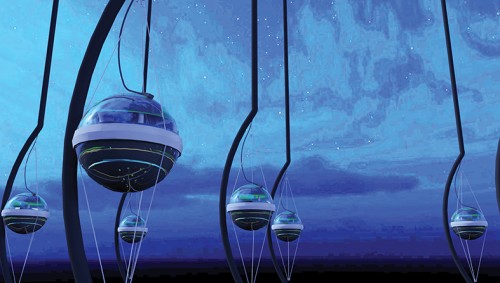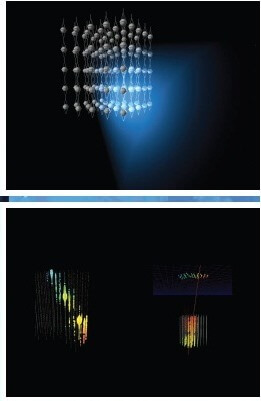Neutrinos that may reach us from cosmological distances, from the vastness of the universe, will be able to teach us about processes that cannot be discerned using light waves

A new perspective may allow us to see things we have not seen before. In the same way, absorption and measurement of different types of particles may reveal to us different and complementary "pictures of the world". For example, when we observe the universe, we usually perceive and measure light waves of different wavelengths (some visible to the human eye and some invisible). But in two cases in the past we came to know that observing neutrino particles (neutrinos) that reach us from different sources in the universe may allow new insights into the world. In both cases it was neutrinos that came to us from relatively close sources: supernova 1987A exploded in a nearby galaxy, and the neutrinos that came from it provided confirmation that the explosion resulted from the gravitational collapse of the star that became a neutron star; The neutrino particles that came from our sun allowed us to understand the energy production mechanism that takes place in its core, and to measure the mass of the neutrinos.
Clues that have emerged in various theoretical studies are that these two cases are but the tip of the iceberg, and that, in fact, neutrinos that may reach us from cosmological distances, from the vastness of the universe, will be able to teach us about processes that cannot be discerned using light waves. This is, in fact, a completely new type of astronomy. For example, we know that in the vastness of the universe there are natural particle accelerators that are 100 million times more powerful than the Large Particle Accelerator (LHC), which is installed at the European Laboratory for the Study of Particle Physics, Saran, near Geneva. We know about these accelerators, because the particles they "launch" at us hit the upper layer of the atmosphere with great force, causing a "meter" of particles that descend into the atmosphere, and are picked up by our measuring devices. But where exactly are these accelerators located? Which particles are accelerated? Protons? Heavy kernels? How exactly do they accelerate the particles to such high speeds? All these questions fascinate astrophysicists around the world.

In the upper picture: the IceCube detector. In the lower picture: on the right we see an event in which the detector detected a neutrino particle that was created in the atmosphere and reached the detector after passing through the entire globe. On the left we see an event of the discovery of a cosmic ray particle that reached the detector after passing through the atmosphere only
Prof. Eli Waxman, from the Department of Particle Physics and Astrophysics at the Weizmann Institute of Science, proposed that the remote accelerators operate near young black holes whose mass is similar to that of the Sun, which are also responsible for the creation of strong gamma ray flashes. In a follow-up work, which he carried out together with Prof. John Beckel from the Institute for Advanced Studies in Princeton, the two proposed a model that predicted that energetic neutrino particles would be created in the acceleration process.
Neutrino particles are chargeless, almost massless, and rarely interact with other matter components. In other words, they come from the ends of the universe, pass through everything that stands in their way, including the Earth and the people who live on it - and continue on their way to unknown destinations. Absorption and identification of these neutrinos, which arrive here from distant sources, may be the beginning of a new astronomy, and perhaps even a new physics. The question is, of course, how to perceive and measure energetic particles that "don't count us", and that hardly interact with any other matter.
If this inherent difficulty was not enough, Waxman and Beckel, as a result of another joint study, added an upper limit to the amount of these particles, according to which (regardless of the source of these nitrites) one particle per square kilometer would reach the Earth per second. From this upper barrier it is deduced that a billion-ton detector placed on Earth will detect, for an entire year, no more than a few tens of energetic neutrino particles originating from those distant cosmological sources. Since it is clear that it is not possible to build such a detector, the scientists turned to nature. This is how they began to build huge detectors in the ice cap that surrounds Antarctica. The complete detector is actually created from a network of small detectors that are installed deep in the Antarctic ice.
The construction of the giant detector lasted several years, and was recently completed. From data collected in the detector in the last two years (in the last stages of its construction and since its completion), it appears that during this period several tens of neutrino particles were detected in the detector - a number very close to Waxman and Beckel's upper limit. This result shows that the neutrinos that were discovered did indeed come from distant cosmological sources, and that the considerations based on which Waxman and Beck created their model are correct. Among these we can mention the following basic assumptions: the accelerators (whose nature is still unknown) are evenly distributed in the universe; They accelerate protons, and in the process neutrinos are created; The different types of nitrites reach us in equal amounts; The acceleration rate of the accelerators increases with distance. That is, a more distant accelerator, which is "older", produces more particles per unit of time (or the density of the accelerators increases the further you go into the past); A significant part of the energy of the accelerators is used to produce the neutrino particles.
Prof. Waxman says that additional data collected by the Antarctic detector must be re-examined in the coming years, and that we still face the mystery of the origins of the accelerated particles. Be that as it may, it seems that from now on scientists will have tools and data available that will allow them to develop a new type of astronomy and astrophysics, and among other things to test various assumptions that underlie the theory of relativity with much greater precision than we are able to today. And as mentioned, observing in different ways may reveal to us facts that we did not know about the universe in which we live.
Prof. Eli Waxman. Point of View
Prof. Eli Waxman

4 תגובות
A little clarification
John Beckel, with whom Eli Waxman published the article, was in the past one of the greatest astrophysicists in the world. The reason why today he is not one of the greatest astrophysicists is that in the last 8 years he died.
http://en.wikipedia.org/wiki/John_N._Bahcall
Waxman and Beckel have several articles in common, five of which (that I found) deal with neutrinos and gamma ray flashes. These articles were published in the years 1997-2001 and two of them received over 500 citations (that's a lot...).
The innovation in this article is not in Waxman and Beckel's theoretical prediction, but in the fact that following the new neutrino detectors we may begin to discover signs of the correctness of the theory in question.
exciting
Human curiosity will lead us forward!
I envy that future generation where they will know how to build a neutrino lens